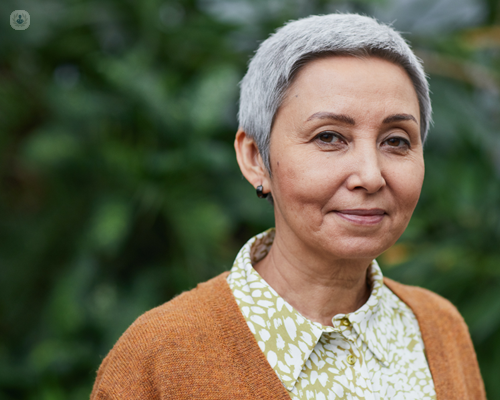Postmenopausal bleeding: Your questions answered
Written by:Postmenopausal bleeding can indicate several factors and it should receive specialist attention. Top Doctors speaks to Mr Osama Naji, a leading consultant gynaecologist based in Marylebone, London, all about this condition. He goes into expert detail about what it is, how serious it is and how long it can last, alongside other important issues.

What is postmenopausal bleeding? What are its symptoms? What causes postmenopausal bleeding?
Postmenopausal bleeding (PMB) refers to vaginal bleeding that occurs after a woman has gone through menopause. Menopause is defined as the cessation of menstrual periods for at least 12 consecutive months, and typically occurs between the ages of 49 and 52.
PMB can be caused by a variety of factors, including thinning of the vaginal tissues (vaginal atrophy), uterine fibroids or polyps, endometrial hyperplasia (thickening of the lining of the uterus), endometrial cancer, or other types of cancer affecting the reproductive organs. Any postmenopausal bleeding should be evaluated by a consultant gynaecologist with expertise in oncology/cancer diagnostics to determine the underlying cause and to rule out more serious conditions such as cancer.
It is important for women to report any abnormal vaginal bleeding to their GP or consultant promptly, regardless of whether or not they have gone through menopause.
Is postmenopausal bleeding a serious condition?
Postmenopausal bleeding can be a serious condition, and any instance of bleeding after menopause should be evaluated by a specialist gynaecologist to determine the underlying cause.
While many cases of postmenopausal bleeding are not related to cancer, it is important to rule out endometrial or other gynecological cancers as a potential cause. Other potential causes of PMB include vaginal atrophy, hormonal imbalances, endometrial hyperplasia, or uterine fibroids or polyps.
Treatment for postmenopausal bleeding will depend on the underlying cause and may include hormone therapy, medication, or surgery.
In general, it is important for women to report any abnormal vaginal bleeding, including PMB, to their GP or gynaecologist as soon as possible. Early detection and treatment of any underlying condition can improve outcomes and reduce the risk of complications.
How long does postmenopausal bleeding usually last?
The duration of postmenopausal bleeding can vary depending on the underlying cause. In some cases, the bleeding may be a one-time occurrence, while in others it may continue for several days or weeks.
The length and frequency of the bleeding will depend on the specific cause of the bleeding. If postmenopausal bleeding occurs, it is important to seek medical attention promptly.
Your consultant may perform a physical examination, order imaging tests such as a vaginal ultrasound, and may need to perform a biopsy of the endometrial tissue to determine the underlying cause of the bleeding.
It is important to remember that any PMB should be taken seriously and evaluated by a healthcare provider.
What treatments are available for postmenopausal bleeding?
Treatment for postmenopausal bleeding will depend on the underlying cause. For example, if the bleeding is caused by hormonal imbalances, hormone therapy may be recommended.
If the bleeding is caused by endometrial hyperplasia or cancer, more aggressive treatment such as surgery or radiation therapy may be required.
Here are some common treatments:
- Hormone therapy
If the bleeding is caused by hormonal imbalances, hormone therapy may be prescribed to regulate the levels of oestrogen and progesterone in the body.
- Medications
In some cases, medications such as progestin or Mirena coil may be prescribed to regulate the menstrual cycle or treat underlying conditions such as endometrial hyperplasia.
- Surgery
If the bleeding is caused by uterine fibroids, polyps or other structural abnormalities, surgery may be required to remove these growths.
- Endometrial ablation
In cases where the bleeding is caused by thickening of the lining of the uterus, a procedure called endometrial ablation may be recommended. This involves removing the lining of the uterus, which can stop or reduce bleeding. However this procedure can only be performed after ensuring a normal endometrial biopsy with no evidence of underlying hyperplasia or malignancy.
In cases where other treatments are ineffective or the bleeding is caused by cancer, a hysterectomy may be necessary. This involves removing the uterus and may also involve removal of the ovaries and fallopian tubes.
It is important to consult with your consultant to determine the appropriate treatment for PMB. Prompt medical attention can help to identify and treat any underlying conditions, improve outcomes, and reduce the risk of complications.
If you’d like to arrange a consultation with Mr Naji in order to receive expert gynecological care, you can do so by visiting his Top Doctors profile.


